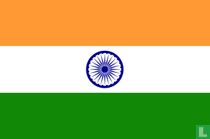Het land India bestaat als postzegel-uitgevend gebied sinds 1852. De eerste zegels werden geïntroduceerd door de Britse Oost-Indië Compagnie, die al vestigingen in India had. Daarnaast waren de Portugezen aanwezig (Portugees Indië = Goa), de Fransen (Pondicherry) en Denen en Nederlanders.
Het land werd sinds 1858 geregeerd als onderdeel van het Britse Rijk. In 1876 werd koningin Victoria tot keizerin gekroond. Het keizerrijk bleef bestaan onder de Britse koningen, waardoor de postzegels steeds het Britse staatshoofd toonden. In 1947 werd India onafhankelijk en riep het de Republiek uit. In feite is het een federatie. Deze zegels vindt u bij India.
De Hindoes zijn de overwegende bevolkingsgroep, maar er zijn honderden kleinere religies. Die hadden, en hebben nóg, vaak hun eigen landsdeel. De Republiek kent thans 29 staten, maar vroeger waren er nog veel meer. Vele daarvan hebben vóór de zelfstandigheid eigen postzegels uitgegeven, sommigen uitsluitend bedoeld als dienstzegels. Daarbij gebruikten enkele staten postzegels van Brits Indië met een opdruk, anderen weer een geheel eigen ontwerp. U vindt ze bij LastDodo onder de gebiedsnaam India – staatsnaam.
Bijzondere aandachtspunten zijn de watermerken en tandingen, terwijl er ook zegels bestaan met net iets afwijkend inschrift. Watermerken kunnen in allerlei posities voorkomen: staand, kopstaand, liggend en omgekeerd liggend.. Bij de modernere langlopende series zijn ook tandingverschillen te vinden, bijvoorbeeld 14½x14 en 13x13, naast verschillende watermerken.
In bijgaande afbeelding ziet u voorbeelden van gebruikte watermerken. Van links naar rechts zijn dat de olifantskop, ster, sterren, Asoka zuil en ster+INDIA GOVT.
Timbres-poste de Inde catalogue
Inde Vue d'ensemble des tampons et des points d'attention pour l'identification En savoir plus
Timbres-poste de Inde

Le pays de l'Inde existe en tant que territoire émetteur de timbres depuis 1852. Les premiers timbres ont été introduits par la British East Indies Company, qui avait déjà des succursales en Inde. De plus, les Portugais (Portuguese Indies = Goa), les Français (Pondichéry) et les Danois et Hollandais étaient présents.
Le pays fait partie de l'Empire britannique depuis 1858. La reine Victoria a été couronnée impératrice en 1876. L'empire a continué d'exister sous les rois britanniques, de sorte que les timbres montraient toujours le chef de l'État britannique. En 1947, l'Inde devient indépendante et proclame la République. En fait, c'est une fédération. Vous pouvez trouver ces timbres en Inde.
Les hindous sont le groupe ethnique prédominant, mais il existe des centaines de religions mineures. Ils avaient souvent, et ont toujours, leur propre partie du pays. La République compte aujourd'hui 29 États, mais dans le passé, il y en avait beaucoup plus. Beaucoup d'entre eux ont émis leurs propres timbres avant l'indépendance, certains destinés uniquement à des timbres de service. Certains États ont utilisé des timbres de l'Inde britannique avec une surimpression, d'autres ont utilisé leur propre dessin. Vous pouvez les trouver sur LastDodo sous le nom de zone India – state name.
Les filigranes et les perforations sont particulièrement intéressants, tandis qu'il existe également des timbres avec des inscriptions légèrement différentes. Les filigranes peuvent apparaître dans toutes sortes de positions : portrait, portrait de tête, paysage et paysage inversé.Les séries longues plus modernes présentent également des différences de perforation, par exemple 14½x14 et 13x13, en plus de différents filigranes.
L'image ci-jointe montre des exemples de filigranes utilisés. De gauche à droite, ce sont la tête d'éléphant, l'étoile, les étoiles, la colonne Asoka et l'étoile + INDIA GOVT.




























































